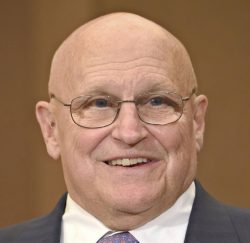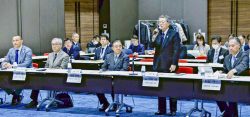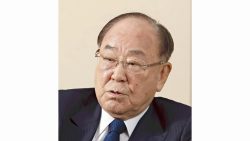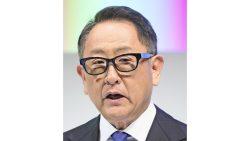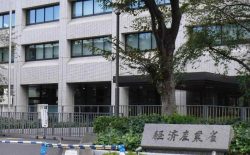
King Frederik X of Denmark, fourth from left, walks on the Grand Ring at the 2025 Osaka-Kansai Expo.
8:00 JST, June 7, 2025
More than 50 days have passed since the 2025 Osaka-Kansai Expo began. Exhibits that evoke the future of society are popular, and the number of visitors is increasing after an initially slow start. Although they tend to be overlooked amid the spectacular exhibits, some events and activities during this 50-day period have reflected the complex state of the world today.
The king’s sales
A procession led by the king of Denmark passed along the Grand Ring, the world’s largest wooden structure and the symbol of the Expo, and made its way to the Japan Pavilion. Visitors held up their smartphones to record the scene.
On April 24, it was Denmark’s turn to mark “National Day,” in which countries participating in the Expo showcase their cultures. King Frederik X — the successor to Queen Margrethe II, who enjoyed immense popularity during her 52-year reign — led the party, which included Danish corporate leaders.
King Frederik chose Japan as the first Asian country to visit after his accession to the throne in January last year, accompanied by a business delegation including Danish Crown, his nation’s largest meat producer. One of the accompanying members wrote in an email before arriving in Japan that she considered this visit to Japan to be “particularly important.”
One reason why is the Trump administration’s tariff policy. Japan is gaining importance as a market amidst the instability of the global free trade system, and it has “a long-standing partnership [with Denmark] grounded in mutual respect and values,” as King Frederik said in a speech at the Expo.
The day before arriving in Osaka, the king stopped by Ippudo, a ramen chain restaurant in Ginza, Tokyo, that uses pork supplied by Danish Crown. He enjoyed a bowl in front of the press, helping to promote Danish products.
‘A window to the world’
Denmark has a population of just under 6 million, which is less than Chiba Prefecture. Two-thirds of its food production is exported, and the country relies on international trade to support its economy. “We are a small country in a big world. So, we are a strong believer of free trade,” stressed delegation member Soren Sondergaard, who is president of the Danish Agriculture & Food Council. “We don’t like tariffs at all. For Denmark, Japan is a big, big, big export market for us where we would like to export more. ”
After leaving the Expo site, Mr. Sondergaard and the delegation went to the head office of Suntory Holdings in Kita Ward, Osaka, which obtained beer manufacturing technology from Carlsberg in Denmark. They met with members of Japanese companies, with the 52 Danish participants exceeding the 42 from Japan. Following the event, a lively reception was held at the PRONTO bar on the ground floor of the building.
Business exchange events related to Denmark are often held in Tokyo, so holding one in Osaka is a rare occurrence. Minister of Food, Agriculture and Fisheries Jacob Jensen emphasized, “I believe that a small country like Denmark, with an open economy, we have huge interest in having loyal and long partnerships with good friends like Japan.”
“When you look at a map, you have Japan here, you have Denmark, long way, 13 hours in a plane directly, but still, we are very close in the way that we do business, in the way that we have values, democracies,” Jensen said. “We have an open society, and we have also trust as a keyword in our society. Even though … we are far from each other in geography, I think we are very close in our mindset. The Expo is a window to the world.”
A diplomatic stage
The Expo also serves as a diplomatic stage in connection with ongoing global conflicts. Israel is exhibiting a 2,000-year-old building stone weighing approximately 1.5 tons from the Old City of East Jerusalem that dates back to the early Hasmonean Kingdom, a Jewish dynasty. The dynasty was established when the Jews regained their independence from Hellenistic rule. Gilad Cohen, Israel’s ambassador to Japan, stated at the opening ceremony on April 23 that “the pavilion expresses the connection between the people of Israel, their homeland and their capital, Jerusalem.”
However, East Jerusalem is an area that Israel occupied after the 1967 Six-Day War. The Palestinian side considers it to be the capital of a future state. Most of the international community, which supports the “two-state solution” between Israel and a future Palestinian state, does not recognize Jerusalem as the capital of Israel and maintains that the status of Jerusalem should be decided through peace talks between Israel and Palestine. An expert on Middle Eastern politics said, “Israel’s exhibition at the Expo could cause controversy over its claim to the territory.”
The Palestinian pavilion at the Expo site had not directly addressed the Gaza conflict. However, as the Israeli Army restarted its military operations in Gaza, the pavilion displayed QR codes at the end of May that link to information about the humanitarian crisis in Gaza to visitors. “The world must see and acknowledge the truth. It’s time for awareness to turn into action,” a Palestinian official said.
“Gaza has endured over 600 days of relentless suffering — children’s lives lost, civilians bombed out of their shelters, famine ravaging communities and aid being misused for military purposes. It’s a humanitarian crisis that demands urgent attention and tangible steps to end the suffering,” the official said.
Russia withdrew from the Expo, but Ukraine is holding an exhibition to convey its position. To show their solidarity, a representative from the European Union visited the pavilion on May 9, followed by King Carl XVI Gustaf of Sweden on the 14th and Norwegian foreign minister Espen Barth Eide on June 2. Taiwan, which China claims as part of its territory, is participating in the Expo under the name of a private company. The absence of the word “Taiwan” in the exhibition area is seen as an attempt to avoid China’s objections by framing it as a “non-governmental” activity.
While the Olympic Games, known as the “Festival of Peace,” uphold political neutrality in the Olympic Charter, the Convention Relating to International Exhibitions that defines the nature of the Expo does not include neutrality provisions. Therefore, politics is not strictly off-limits.
The Expo is often referred to as “a mirror of the times.” With just over four months remaining, we will witness more realities of the global situation at this festive event.
Political Pulse appears every Saturday.

Kenji Nakanishi
Kenji Nakanishi is a deputy editor in the City News Department of the Yomiuri Shimbun Osaka.
"Editorial & Columns" POPULAR ARTICLE
-

Mt. Fuji Eruption: Preparations Necessary for Widespread Ashfall
-

Nippon Steel’s Acquisition To Be Approved: Deal Should Be a Symbol of Japan-U.S. Economic Cooperation
-

Basic Economic, Fiscal Policy Draft: Deepen Strategy to Increase Take-home Pay
-

With Trump Back, Japan Must Expand Foreign Policy
-

U.S. Tariffs Blocked: Can Judiciary Prevent The President from Abusing Power?
JN ACCESS RANKING
-

Visitors to Japan Hit Single-Month Record High in April
-

Aichi Rice Production Under Siege from Warming Climate; Record Heat Stunts Crop Growth, Causes Greater Pest Activity
-

Japanese Researchers Develop ‘Transparent Paper’ as Alternative to Plastics; New Material Is Biodegradable, Can Be Produced with Low Carbon Emissions
-

Japan’s Core Inflation Hits More than 2-year High, Could Force Year-End BOJ Hike
-

Japan’s Maglev Shinkansen’s Partially Completed Station Unveiled; Station Will Be Only Underground Stop Between Shinagawa, Nagoya


